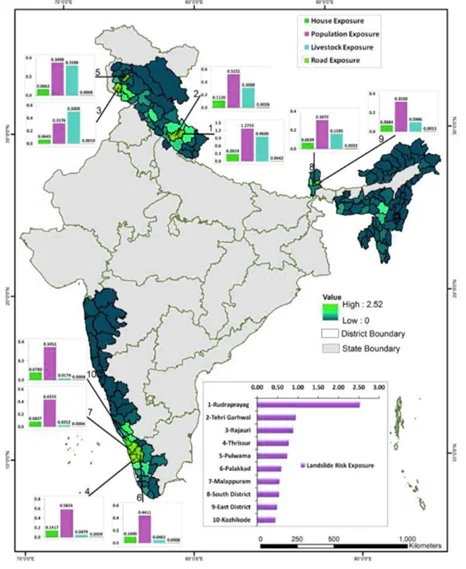Answer:
| Approach:
Introduction
- Brief about significant loss by Landslide.
Body
- Discuss about the Causes of Landslides Effects of Landslides.
- National Landslide Risk Management Strategy.
Conclusion
- Conclude your answer with a significant future stick approach.
|
Introduction:
Landslides are one of the most destructive natural disasters, causing significant loss of life and property damage globally. They can be triggered by a range of factors, including human activities, geological and environmental conditions.

Body:
- Causes of Landslides:
- Geological Factors: Geological factors such as the type of soil and rock, slope angle, and slope stability can contribute to landslides. For example In Himachal Pradesh steep slopes with loose soil and rock are more prone to landslides.
- Natural Factors: Natural factors such as heavy rainfall, snowmelt, earthquakes, and volcanic activity can trigger landslides. For example, In Assam heavy rainfall can saturate the soil, causing it to become unstable and slide downhill.
- Human Factors: Human activities such as deforestation, mining, and construction can also contribute to landslides. For example In Kerala deforestation can destabilize slopes, leading to landslides.
- Effects of Landslides:
- Loss of Life: Landslides can cause fatalities and injuries to people in the affected areas.
- Damage to Property and Infrastructure: Landslides can damage or destroy buildings, roads, bridges, and other infrastructure, leading to economic losses.
- Environmental Damage: Landslides can cause significant environmental damage, such as soil erosion, loss of vegetation, and changes to watercourses.
- National Landslide Risk Management Strategy:
- Hazard Assessment: Conducting a hazard assessment is the first step in developing a National Landslide Risk Management Strategy. This involves identifying areas prone to landslides and evaluating the potential impact of landslides on people, property, and infrastructure.
- Risk Mapping: Mapping the risk of landslides is essential to developing effective risk management strategies. This involves identifying vulnerable areas and prioritizing them for risk reduction measures.
- Early Warning Systems: Early warning systems can alert people in at-risk areas before landslides occur. These systems can include sensors, monitoring devices, and communication networks.
- Land Use Planning: Land use planning can help reduce the risk of landslides by regulating human activities in high-risk areas. This can include zoning regulations, building codes, and land management practices.
- Public Education and Awareness: Public education and awareness campaigns can help people in at-risk areas understand the risks associated with landslides and how to prepare for them. This can include developing emergency plans and evacuation procedures.
Conclusion:
Landslides are a significant natural hazard that can cause extensive damage and loss of life. National Landslide Risk Management Strategy in place, the risks associated with landslides can be significantly reduced. By implementing hazard assessments, risk mapping, early warning systems, land use planning, and public education and awareness campaigns, we can mitigate the impacts of landslides and protect communities from this natural hazard.
